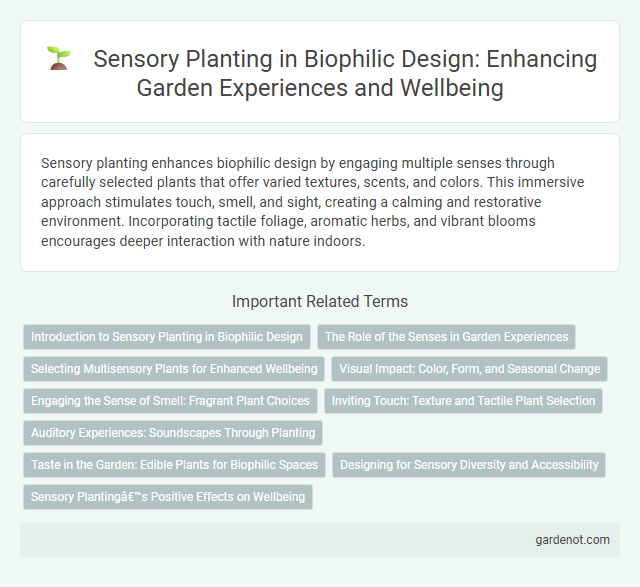Sensory planting enhances biophilic design by engaging multiple senses through carefully selected plants that offer varied textures, scents, and colors. This immersive approach stimulates touch, smell, and sight, creating a calming and restorative environment. Incorporating tactile foliage, aromatic herbs, and vibrant blooms encourages deeper interaction with nature indoors.
Introduction to Sensory Planting in Biophilic Design
Sensory planting in biophilic design harnesses diverse plant textures, colors, scents, and sounds to create immersive natural environments that engage multiple senses. Incorporating aromatic herbs, soft foliage, and rustling grasses enhances user connection to nature, promoting well-being and cognitive restoration. Effective sensory planting strategies prioritize native species and seasonal variations to foster dynamic, resilient landscapes aligned with biophilic principles.
The Role of the Senses in Garden Experiences
Sensory planting enhances garden experiences by engaging sight, smell, touch, and sound through diverse plant textures, colors, and fragrances, fostering emotional well-being and connection to nature. Strategic use of aromatic herbs like lavender and tactile plants such as lamb's ear stimulates multiple senses, creating immersive environments that promote relaxation and mindfulness. Incorporating sensory elements in biophilic design supports cognitive restoration and encourages prolonged interaction with green spaces.
Selecting Multisensory Plants for Enhanced Wellbeing
Selecting multisensory plants such as lavender, jasmine, and rosemary enhances wellbeing by engaging multiple senses, including sight, smell, and touch, within biophilic design spaces. These plants stimulate olfactory and tactile senses while adding vibrant colors and textures, contributing to stress reduction and cognitive restoration. Incorporating greenery with diverse sensory attributes supports mental health and fosters a deeper connection to nature indoors.
Visual Impact: Color, Form, and Seasonal Change
Sensory planting in biophilic design enhances visual impact through strategic use of color, form, and seasonal change, creating dynamic landscapes that engage the human eye. Vibrant hues, diverse plant shapes, and evolving seasonal patterns foster emotional well-being and a strong connection to nature. Optimizing these elements supports restorative environments and elevates architectural aesthetics with natural artistry.
Engaging the Sense of Smell: Fragrant Plant Choices
Fragrant plant choices in biophilic design enhance sensory planting by engaging the sense of smell to create immersive, calming environments. Incorporating aromatic species such as lavender, jasmine, and rosemary stimulates olfactory receptors, promoting relaxation and mental well-being. These scent-rich plants also improve indoor air quality and contribute to a multisensory spatial experience that supports human connection with nature.
Inviting Touch: Texture and Tactile Plant Selection
Selecting plants with varied textures such as soft lamb's ear, coarse ornamental grasses, and smooth succulents enhances the tactile experience in biophilic design. Incorporating sensory planting prioritizes inviting touch, encouraging physical interaction and fostering a deeper connection with nature. Emphasizing tactile diversity supports well-being by stimulating sensory perception and creating engaging, restorative environments.
Auditory Experiences: Soundscapes Through Planting
Sensory planting enhances auditory experiences by incorporating plant species that create soothing soundscapes, such as rustling grasses, rustling leaves, and cascading water features. Strategic placement of bamboo, reeds, and wind-sensitive plants adds natural sound elements that mask urban noise and promote tranquility. This approach enriches biophilic design by engaging hearing senses, fostering a calming environment through nature-inspired acoustic textures.
Taste in the Garden: Edible Plants for Biophilic Spaces
Edible plants like herbs, berries, and fruit trees enhance biophilic spaces by stimulating the sense of taste, creating a multisensory garden experience. Incorporating sensory planting with flavorful crops such as basil, mint, strawberries, and cherry tomatoes fosters direct interaction and promotes wellbeing through taste. This approach connects individuals to nature's bounty, reinforcing a sustainable and engaging environment in biophilic design.
Designing for Sensory Diversity and Accessibility
Sensory planting in biophilic design enhances accessibility by incorporating diverse textures, scents, and colors to engage multiple senses for individuals with varying sensory processing abilities. Designing for sensory diversity involves selecting plants that provide tactile, olfactory, and visual stimuli, ensuring inclusive environments for people with disabilities such as visual impairments or autism. Strategic placement and maintenance of sensory plants optimize user interaction and support therapeutic benefits in healthcare, educational, and public spaces.
Sensory Planting’s Positive Effects on Wellbeing
Sensory planting enhances wellbeing by stimulating multiple senses through the strategic use of textures, colors, and scents, which reduce stress and improve mood. Exposure to fragrant flowers, tactile foliage, and vibrant colors fosters a calming environment, promoting mental clarity and emotional balance. Incorporating sensory plants into biophilic design supports cognitive function and encourages relaxation, contributing to overall psychological health.
Sensory planting Infographic

 gardenot.com
gardenot.com